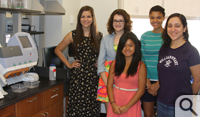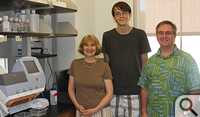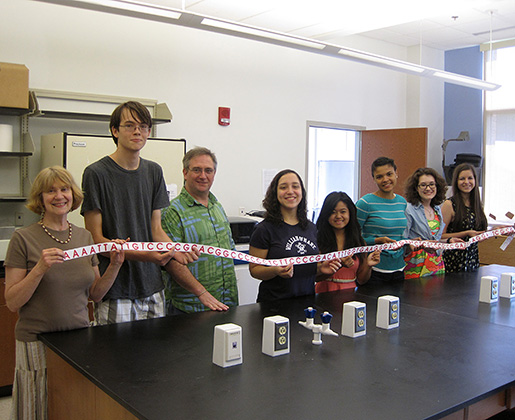A summer of sequencing
Rising William & Mary sophomores make impressive gains in the lab
It was the summer that the freshmen ruled the sequencer.
Technically, the six William & Mary students who logged heavy lab time with a state-of-the-art Ion Torrent gene sequencer had finished their freshman year and therefore did their summer work as rising sophomores.
 But never mind quibbles. Working as a group, Eileen Ablondi, Catherine Acio, Emma McGregor, Caitlin Paisley and Cheyenne Williams not only finished the sequencing of the complete genome of a human bacterial pathogen, but they also attempted RNA-Seq—a technique that sequences expressed genes—on samples from the developing nervous system of a species of frog commonly used in lab experiments. On a different front, Andrew Halleran conducted a transcriptome analysis of a “boring” bacteriophage, a virus that turned out to be not so dull, after all.
But never mind quibbles. Working as a group, Eileen Ablondi, Catherine Acio, Emma McGregor, Caitlin Paisley and Cheyenne Williams not only finished the sequencing of the complete genome of a human bacterial pathogen, but they also attempted RNA-Seq—a technique that sequences expressed genes—on samples from the developing nervous system of a species of frog commonly used in lab experiments. On a different front, Andrew Halleran conducted a transcriptome analysis of a “boring” bacteriophage, a virus that turned out to be not so dull, after all.
All these members of the class of 2016 conducted their work using a state-of-the-art gene sequencing tool under the mentorship of Chancellor Professor of Biology Margaret Saha and Associate Professor Mark Forsyth.
And, these six students did their sequencing while holding down summer positions in other biology labs.
It evolved from the Freshman Phage Lab
The sequencing projects evolved from initiatives made possible by funding from the Howard Hughes Medical Institute (HHMI). The institute’s support established the HHMI SEA-PHAGES program at 70 universities, including William & Mary, where the experience is known as the Freshman Phage Lab. SEA-PHAGES gets new college students doing authentic research through experiences centered on the isolation and examination of bacteriophages, a class of viruses that infect bacteria. HHMI support at William & Mary also made possible a second initiative, the Freshman Genomics Lab. Both experiences provide excellent background for the rigors of next-generation sequencing.
Sequencing is used to identify and investigate the genes contained in a DNA molecule by mapping out all of the nucleotides—adenine, cytosine, guanine and thymine—that make up the rungs on the DNA ladder. It’s something college freshmen learn about, but next-gen sequencing is a process that young students virtually never actually do.
 Halleran was a Phage Lab veteran who stuck with a phage, a virus isolated by the lab in 2012 and given the name Kampy, a handle that is very much in the whimsical naming tradition of the Phage Lab participants. Kampy was, to all appearances, an undistinguished bacteriophage. But the moral behind the story of Kampy might be that there are no boring phages, only uninspired researchers.
Halleran was a Phage Lab veteran who stuck with a phage, a virus isolated by the lab in 2012 and given the name Kampy, a handle that is very much in the whimsical naming tradition of the Phage Lab participants. Kampy was, to all appearances, an undistinguished bacteriophage. But the moral behind the story of Kampy might be that there are no boring phages, only uninspired researchers.
“I was kind of disappointed that it wasn’t genetically very different from several other phages,” he said. “But I figured that if I kept looking at it from different angles, eventually it would come to something scientifically novel. In particular, it seemed that very little was known about which genes were actually expressed during infection.”
Halleran stuck with Kampy, working on its transcriptome between stints at his regular summer gig in Oliver Kerscher’s lab. Halleran’s mRNA transcriptome can provide insight into how RNA takes the genetic information from Kampy’s DNA to create the proteins necessary to carry out gene expression. He said he saw an opportunity to use Kampy as a model, even though his bacteriophage belonged to the A4 group, generally regarded as a quotidian cluster of the organisms.
Halleran’s results revealed global patterns of gene expression in Kampy, as well as the identification of suites of related genes that experienced a change in transcript abundance. For example, he found that six genes in the glyoxylate pathway, an anabolic pathway with several intermediate products, were upregulated during the course of Kampy infection. He also saw several Kampy genes, including the major capsid and the lysozyme, experience severe upregulation.
Invited to present at Janalia Farm
His work paid off, as Halleran was one of the students selected to present his findings at HHMI’s Janalia Farm Research Campus.
“Andy’s presentation was a big accomplishment in itself,” Saha said, noting that the work had enough scientific value to merit the attention to his talk, which bore the clever title “Another A4, now what?: Novel approaches for continued discovery.”
The bacterium and frog RNA sequencing experiments were offshoots of the HHMI-supported Freshman Genomics Lab, which takes young scientists a step beyond Phage Lab and introduces them to the work being done by faculty.
“Phages are wonderful, but phages are not always the focus of the instructors’ research programs,” Saha said, “So, here is the idea: Whomever was teaching this Freshmen Genomics Lab would bring the students into their own genomics research projects, and introduce them to a new field that is increasingly important in biology.”
Nearly half of the participants in the lab signed up to work in various biology department labs over the summer, Forsyth said. “They really caught the research bug,” he added. The summer of sequencing allowed faculty to realize a goal of sustaining the freshman experience beyond the discoveries of the freshmen lab.
“Sequencing a bacterial genome is not at all novel in the field,” Saha said. “However, to have a group of freshmen sequencing it—not sending it out for sequencing—actually doing every single step of the entire procedure themselves, I would speculate it may not have been done anywhere in the country.”
The sequencing process may be high-tech, but it requires many, many painstaking hours of human lab time working with a set of reagents to prepare the sample.
“It’s a long procedure,” Saha said. “It’s time-sensitive and there are hundreds of steps—and any mistake in any one of those steps will just totally trash the sequence.”
The process requires careful and uninterrupted attention. “You reach points at which you can’t stop,” Forsyth explains, adding that many times the students reported to the lab early in the morning and were hard at work until 8 or 9 p.m. The hours may have been long, but Catherine Acio says that the time never dragged.
Their long hours of careful work paid off. The students were able to complete the sequence of a strain of Helicobacter pylori, a bacterium that’s the subject of much of Forsyth’s work. They worked on the J75 strain, known as “one of the wimps,” by Forsyth’s friends in medical school labs. He explained that J75 is known as a wimpy strain because, unlike the more notorious varieties of H. pylori, J75 is not associated with ulcers or gastric cancers in humans.
A wimp of evolutionary importance
Its relatively benign presence in humans doesn’t mean that J75 is unimportant, though. Forsyth explained that the students’ examination of J75’s genome will be valuable in studying the role that evolution has played in the development of the more virulent forms of the Helicobacter pylori bacterium. The bad H. pylori carry a suite of genes not found in J75 and others of the mild-mannered, ancestral, strains.
“These ancestral strains are the ones that have been associated with humans for the longest period of time,” Forsyth continued. “At some point in their evolutionary history, some strains gained a suite of genes that allowed them to cause very severe disease.” The freshmen did indeed identify several regions that were absent from the J75 strain, but in addition they observed stretches of unique sequence that were present only in this non-pathogenic strain.
The freshmen’s sequencing of J75’s genome will be useful in the quest by Forsyth and other scientists to understand how Helicobacter pylori evolved from an unknown, asymptomatic gastric companion to an infectious agent causing widespread illness and death.
At the same time that the five freshmen were working to finish sequencing the 1.7 million base pairs of J75’s DNA for Forsyth’s lab, they were working on an unrelated project—sequencing the micro RNA of Xenopus embryos.
Xenopus is a frog studied by Saha’s lab in an attempt to understand the considerable self-healing and regenerative capacity of embryos. It’s work that has potential relevance for wound healing and regenerative medicine.
“Embryos, far more than tissues in mature organisms, have the ability to compensate for various perturbations—environmental and genetic,” Saha explained. “We are trying to understand the mechanisms by which embryonic tissue can do this.”
She believes that early biochemical calcium activity in the embryonic cells is responsible for at least some of the resilience of embryos. The freshmen group of five sequenced microRNA from Xenopus from embryos with up-regulated calcium activity and identified more than 600 possible miRNA sites on the X. laevis genome. The students’ work will help Saha determine the specific miRNA molecules that are important for the genetic pathways leading to the embryo’s regenerative capacity.
Greatest gain? Confidence in the lab
The six members of the class of 2016 were responsible for some real contributions to science, but Forsyth and Saha say that the larger gain from the summer of the sequencer was educational. With their freshman year barely behind them, the young scientists have experience and perspective that not even all graduate students can claim.
“These experiences will allow them to understand every aspect of this procedure,” Saha said. “There is no substitute for doing every step of this yourself. You learn more, because have to troubleshoot and criticize and analyze. Consequently, you know what’s going on with your end product that you would have no idea if you didn’t do it yourself.”
“It gives them a sense of confidence, too,” Forsyth added. “If, as freshmen, they can conquer something as complicated and involved as genome sequencing, then there are probably not many barriers that they can’t overcome.”















